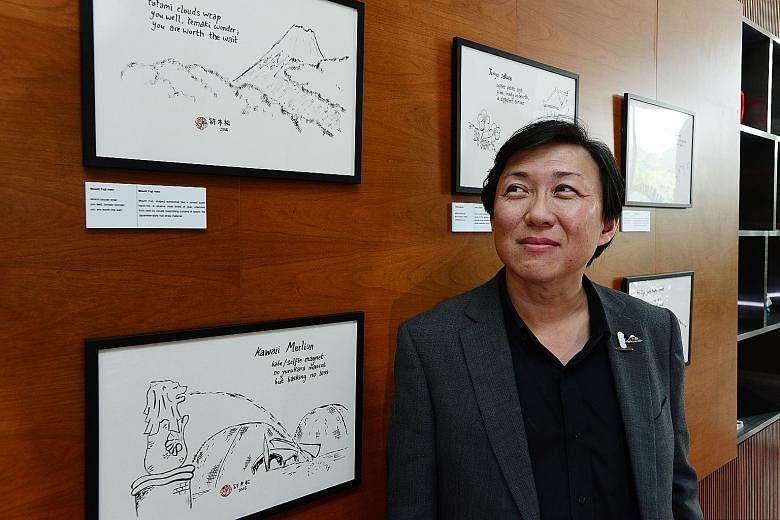Many have tried their hand at Japanese haiku, counting off the syllables for these three-line poems, but the term haiga is likely to meet with raised eyebrows.
Writer and brand consultant Koh Buck Song is hoping to change that.
The traditional Japanese art form, he says, can go down well in today's world, with people's dwindling attention span and rising appetite for punchy text and striking graphics.
With his exhibition, Six Views Of Japan And Singapore, he sheds light on the haiga, which combines visual art and haiku.
"It's an ancient form dating back to the 16th century and yet, so few artists and poets practise it. It even seems so new and novel to us in the 21st century," says Koh, 53.
-
VIEW IT / SIX VIEWS OF JAPAN & SINGAPORE - A HAIGA EXHIBITION
-
WHERE: Festival Corner, Esplanade
WHEN: Till tomorrow
ADMISSION: Free
"It also seemed to me that haiga is an art form particularly conducive to our times, in this cyber age of short attention spans, in which concise, meaningful words and a striking visual element - on Facebook, for example - are what catches people's attention best. Haiga can be savoured and shared, complete on one smartphone screen."
He has - in his exhibition at the Esplanade's Festival Corner - captured images from Japan and Singapore in simple ink sketches accompanied by haiku that range from the introspective to the humorous.
These include Mount Fuji and the Merlion - "the national symbols of Japan and Singapore" - as well as Marina Bay, in a sketch that evokes the composition of 18th-century Japanese artist Katsushika Hokusai's most famous woodblock print, The Great Wave Off Kanagawa. The exhibition, part of the Esplanade's Super Japan - Japanese Festival of Arts, runs till tomorrow. Visitors can also create their own haiga there.
Koh, who has written and edited more than 25 books over the years, first discovered the form last year, while he was reading up on Japan ahead of a trip there at the invitation of the Japan Foundation.
The weaving of two of his great loves in the arts - poetry and visual arts, a medium he had always wanted to explore - fascinated him.
He dove into research, reading up on the form and speaking with a haiga publisher in Tokyo.
Koh's two-week trip around Japan took him to Tokyo, Kyoto, Okinawa and Yamanashi prefecture - fertile grounds for inspiration for his haiga.
One haiga is devoted to the elusive Mount Fuji, which is shrouded in cloud most of the day.
Another, Kyoto Autumn, has a sketch of a ginkgo leaf with a spider resting on it - a rendition of a leaf Koh picked up during a stroll through the grounds of Kyoto University. He pinned it to his jacket, planning to bring it back to Singapore, but it dropped amid the bustle around the Gion heritage district, "perhaps perfectly illustrating the transience of beauty".
Koh hopes his haiga will stoke in people of all ages a renewed appreciation of art and poetry and encourage them to expand their imagination.
"The novelty of the art form to most people might encourage them that there are still 'blue ocean' spaces for them to discover and explore," he says.
"I hope people here will create and share haiga extensively one day."


